What Is the Metropolitan Museum Art Shape New York
MET Fifth Artery – The Metropolitan Museum of Art
1000 Fifth Avenue , New York
New York, United States
closed on: open daily, except Thanksgiving Day, December 25, January 1, and the kickoff Monday in May
Museum Blazon: Art, Decorative arts / Handicraft, Mode, Music / Musical instruments
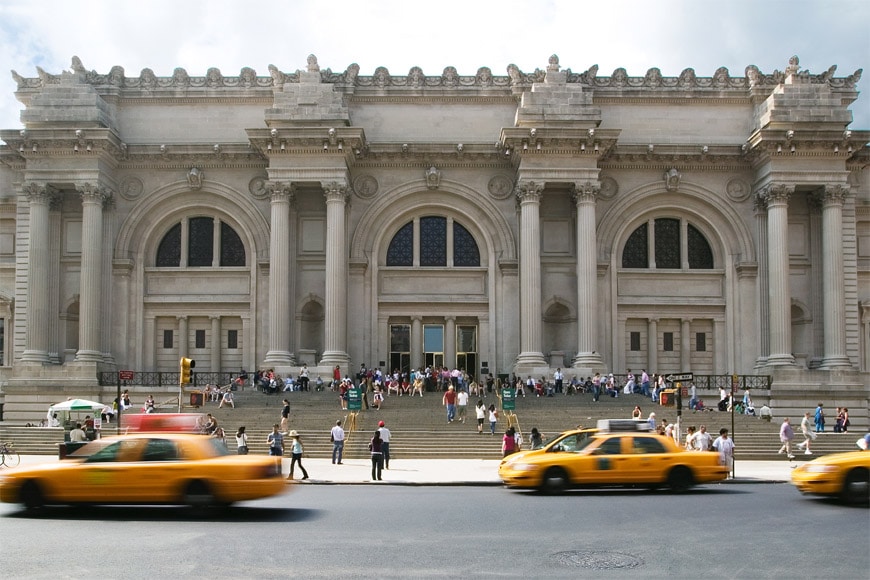
TheMetropolitan Museum of Art (too known as the Met) in New York is one of the world's largest museums of fine and applied arts. With over half dozen one thousand thousand visitors a twelvemonth, the MET is the most visited art museum in the United States.
History and buildings
The museum was opened to the public for the first time in 1870 with the aim "to bring fine art and art education to the American people". Since 1880, the museum'southward main edifice is located on the 5th Artery in Manhattan site bordering Central Park.
The MET'southward original building on Fifth Avenue, still partially visible, was designed in the late 19th century by architectsCalvert Vaux andJacob Wrey Mould as an imposing Gothic-revival palace, and repeatedly enlarged thereafter. The current facade on 5th Avenue was built in 1902 afterward a design by Richard Morris Hunt.
A major expansion plan, designed by Kevin Roche John Dinkeloo and Associates, was carried out betwixt 1975 and 1991.
Today, the MET Fifth Artery is one of the largest museums in the earth, with a gross floor area of some ii meg square feet (180,000 square meters).
In September 2014, the MET inaugurated a new 1,021-foot-long / 300-meter-long public space, known asDavid H. Koch Plaza, situated in front of the museum's principal archway on the 5th Avenue. Designed by American mural and urban design firm OLIN, the new plaza is a country of the art contemporary outdoor space that ideally completes the south-westward historical facade of the MET. With an expanse of 70,706- square feet / 6,500 square meters, the Koch Plaza is paved in Maine's granite stone, and equipped with seats, parasols, fountains, 106 Footling Foliage Linden and London Airplane trees, and a sustainable LED lighting system.
The MET has a branch located in northern Manhattan,The Cloisters Museum and Gardens, which contains a large drove of medieval art and compages. Since March 2016, the MET presents modern and contemporary fine art exhibitions in a new venue in Midtown Manhattan, theMET Breuer, formerly the dwelling house of the Whitney Museum of American Art.
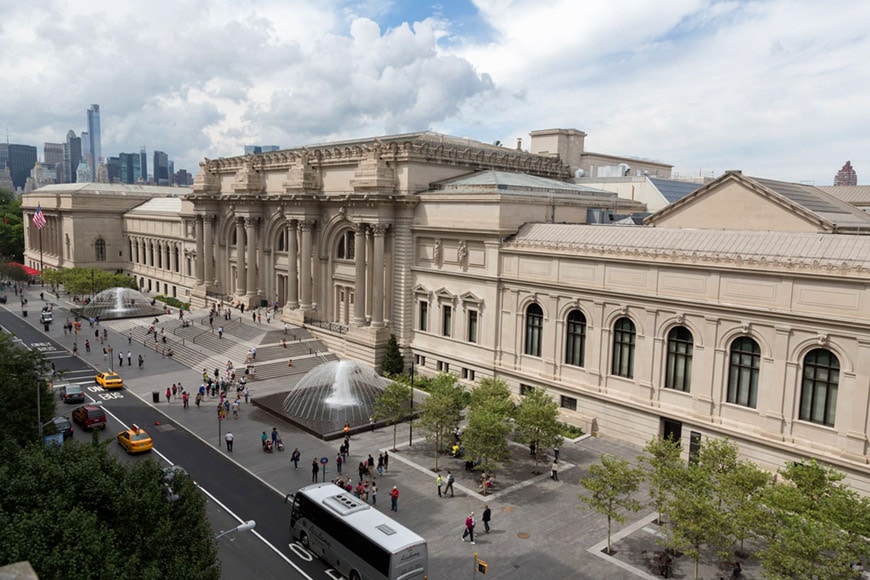
The MET Fifth Avenue and the David H. Koch Plaza in New York City; photo © The Metropolitan Museum of Art
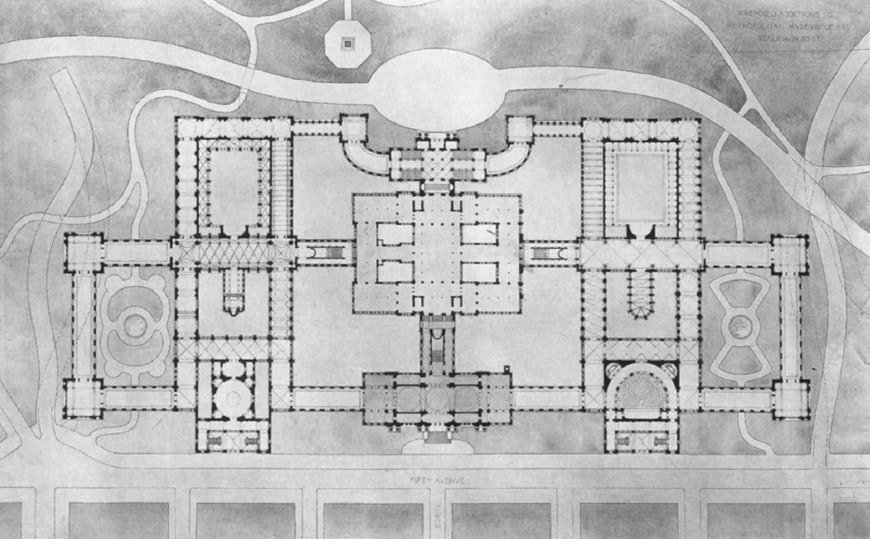
Masterplan for the MET's expansion by Richard Morris Chase (early 1890s)
Collection and permanent exhibition
Like the Louvre and the British Museum, the Metropolitan Museum of Fine art is an "encyclopaedic" museum, with departments covering various forms of artistic expression: American art, Aboriginal near-eastward art, Arms and armor, Fine art of Africa, Oceania and the Americas, Asian art, Costume, drawings and prints, Aboriginal Egypt, European paintings, European sculpture and decorative arts, Aboriginal Greek and Roman art, Islamic art, Medieval art, Modern and contemporary art, Musical instruments and Photography.
The immense drove of the MET, which amounts to more than two million pieces, ranges
from Caravaggio's paintings to Stradivari'south violins, from works past Picasso and Van Gogh to Balenciaga's haute couture dresses, from Egyptian sarcophagi to artworks by Francisco Goya or Wassily Kandinsky, to proper noun a few.
Selected objects from the museum'due south collection are exhibited into thematic sections, each encompassing several rooms. Some of such "rooms" are actually grandiose spaces, such as the Sackler Fly , defended to ancient Egyptian art and architecture, the European Sculpture and Decorative Arts hall, and the Greek & Roman Galleries .
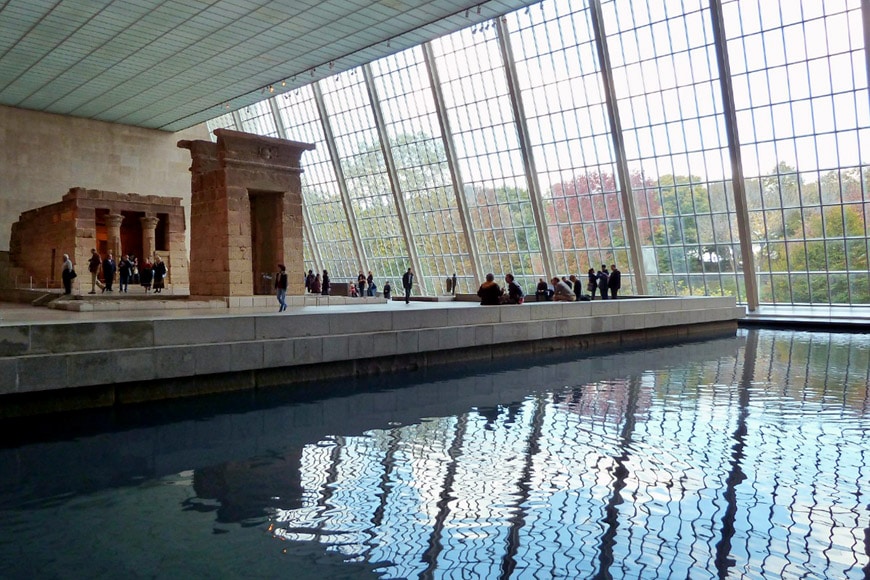
The Temple of Dendur (1st century B.C., Egyptian, Roman catamenia), Sackler Wing; photo: Tony & Wayne
Masterpieces on view
Earth-renownedpaintings on view at the MET include Fresco from the Villa of P. Fannius Synistor at Boscoreale (Roman, ca. 50–40 B.C.),Portrait of a Lady, (c. 1450) by Paolo Uccello, The Annunciation (ca. 1485-92) past Botticelli,The Harvesters (1565) by Pieter Bruegel the Elder,Christ Carrying the Cross (ca. 1577–87) by El Greco,The Musicians (c. 1595) by Caravaggio, Portrait of Juan de Pareja (1650) by Diego Velázquez,Woman with a Lute (1662) by Johannes Vermeer, Portrait of Gerard de Lairesse (1665–67) past Rembrandt, The Dancing Class (1872) by Edgar Degas,Self-Portrait with Straw Hat (1887) by Vincent Van Gogh, The 4 Trees (1891) by Claude Monet, Seated Harlequin (1901) andThe Oil Mill (1909) past Pablo Picasso, Self-Portrait (1911) by Egon Schiele, Reclining Nude (1917) past Amedeo Modigliani, The Lighthouse at Two Lights (1929) by Edward Hopper,Fall Rhythm – Number 30 (1950) by Jackson Pollock, and No. xiii – White, Ruddy on Xanthous (1958) by Mark Rothko, to name only a few.
Outstanding sculptural works include Head of Tutankhamun (limestone sculpture, Egyptian, ca. 1336–1327 B.C.),Ritual Effigy (wood sculpture, Egyptian, 380–246 B.C.), Bronze portrait of a homo (Roman, start one-half of 1st century A.D.),Virgin and Kid (1470-75) by Andrea della Robbia, Triton (1560–70) past Giambologna,Bacchanalia: A Faun Teased past Children (ca. 1616–17) by Gian Lorenzo Bernini,Perseus with the Caput of Medusa (1804–six) by Antonio Canova,Adam (modeled 1880 or 1881, cast 1910) by Auguste Rodin, and 3 Men Walking II (1949) past Alberto Giacometti, among others.
Along with paintings and sculptures, the MET museum's collections include infrequent drawings, such as theCaput of the Virgin in Three-Quarter View Facing Right (1510–1513) by
Leonardo da Vinci; photographs – including xv, rue Maître-Albert (1912) by Eugène Atget, From the Back Window – 291 (1915) by Alfred Stieglitz, Man Ray'due south Rayographs of the '20s, andSchiphol (1994) by Andreas Gursky -;pieces of article of furniture, including theFarnese Tabular array (ca. 1565–73) by Jacopo Barozzi da Vignola; musical instruments, such as the ex "Kurtz" violin (ca. 1560) past Andrea Amati andThe Gould violin (1693) by Antonio Stradivari.
The MET Fifth Avenue as well features a number of architectural elements and even entire buildings, such as the famous Temple of Dendur, on view in the Sackler Fly; yet, many architectural items from the Metropolitan Museum'due south collection are exhibited at The Cloisters.
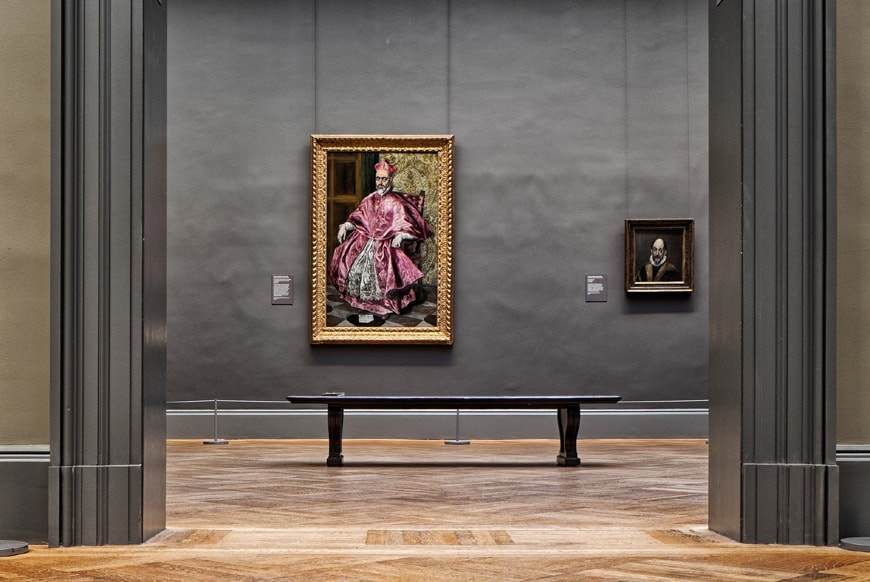
View of MET'south Gallery 611, with the paintings Central Fernando Niño de Guevara (ca. 1600), and Portrait of an Old Homo (1595-1600) past El Greco (Domenikos Theotokopoulos); photograph: Timothy Neesam
Additional services and activities
The Metropolitan Museum of Art organizes temporary exhibitions, guided tours, art workshops, music concerts and alive performances, educational programs for families, adults, and kids, as well as touring exhibitions, and research programs.
The MET complex includes a library for professionals and a library open to all, various departmental libraries and study rooms, the Ruth and Harold D. Uris Center for education, a museum store, a cafe, ii self-service restaurants, a fine-dining restaurant, and a panoramic roof garden – frequently used for special events and special art installations.
The Metropolitan Museum of Art is fully accessible to physically impaired persons.
Prototype Gallery


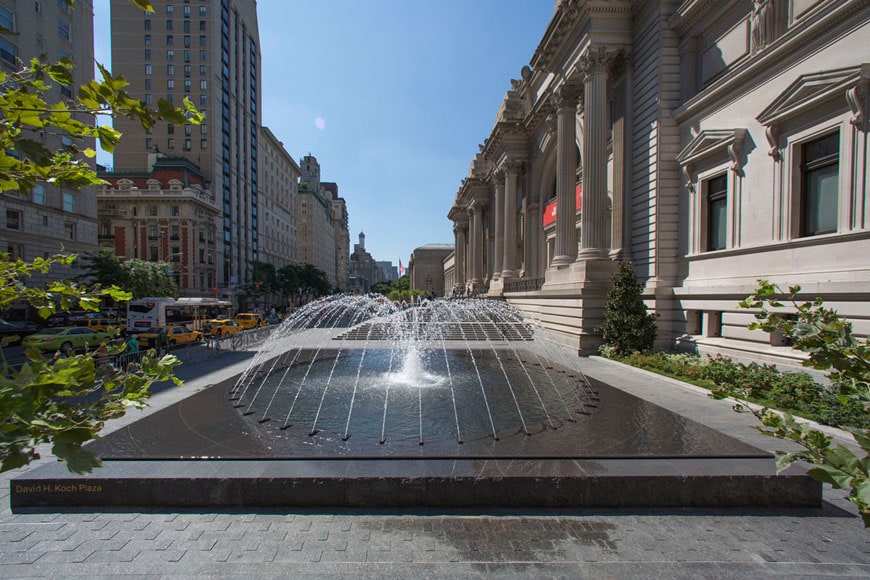
MET Fifth Avenue, exterior views of the museum's due south-east facade and the David H. Koch Plaza. Photos © The Metropolitan Museum of Fine art

MET Fifth Avenue, Carroll and Milton Petrie European Sculpture Court; photograph: Aránzazu

Cubiculum (bedroom) from the Villa of P. Fannius Synistor at Boscoreale, ca. 50–40 B.C.. MET 5th Avenue, gallery 165; photo courtesy of MET

Ritual Figure (particular), 380–246 B.C., woods (formerly clad in lead, )MET Fifth Artery, gallery 128; photo courtesy of MET

Leonardo da Vinci, The Head of the Virgin in Three-Quarter View Facing Correct, 1510–1513, black chalk, charcoal, and scarlet chalk on paper, usually non on view; photograph courtesy of MET

Bronzino (Agnolo di Cosimo di Mariano), Portrait of a Immature Man, ca. 1530, oil on wood, MET 5th Avenue, gallery 609; photo courtesy of MET

Vincent Van Gogh, Wheat Field with Cypresses, 1889, oil on canvas, MET 5th Avenue, gallery 822; photo courtesy of MET

Pablo Picasso, Seated Harlequin, 1901, oil on canvas, Met Fifth Avenue, gallery 830
Cover paradigm: Facade of the Metropolitan Museum of Art on Fifth Avenue; photo by Evan Lee, courtesy of MET
Source: https://www.inexhibit.com/mymuseum/metropolitan-museum-art-new-york/